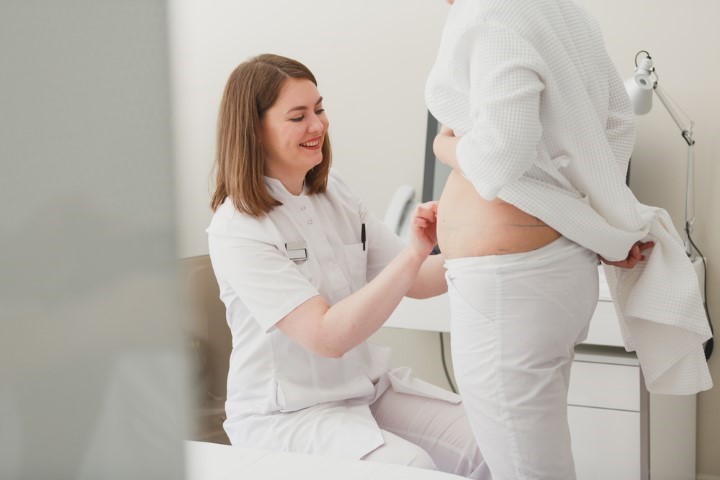Common Myths about Liposuction
Nearly all of us have at least one area of our body that we want to slim down, so it’s no surprise that fat removal—called liposuction—has long been among the most popular cosmetic surgeries in the country. But it’s also one of the most misunderstood surgeries, too. As a double board-certified plastic surgeon, I strive to educate patients and potential patients about the field of plastic surgery, so to help you know the true facts about liposuction, I’ve compiled answers to some of the most common liposuction myths that might trick you.

While both weight loss and liposuction have the goal of reducing fat, they’re done in two very different ways and for two very different purposes. For the most part, you have the same number of fat cells throughout your life, and weight gain and weight loss happen when these fat cells either enlarge or shrink. Liposuction, on the other hand, manually removes some of the fat cells in an extremely specific area. The core difference is that weight loss, for people who are overweight, reduces total body fat (including the fat surrounding internal organs, the type that tends to cause health problems) for overall better health and a slimmer appearance throughout the entire body. Liposuction, on the other hand, is designed for people who are already a healthy weight and simply have one or a few specific “problem areas” (like “love handles” or a “double chin”) for which they just need a cosmetic fix. So the bottom line is that if you’re overweight, it’s best to lose weight the old fashioned way and then, if necessary, use liposuction to polish off the cosmetic results after you’ve reached your goal weight.
Myth #2: After liposuction has removed fat cells, the fat is gone for good.
Technically, the excess fat cells liposuction removes won’t grow back. However, your remaining fat cells (both in the treatment area and throughout the rest of your body) are just as capable of enlarging as they were before. Taking in more calories than you’re burning can and will result in weight gain regardless of whether you’ve had liposuction, so the best way to make sure your treatment area stays slender is to keep up with a healthy diet and exercise regimen.
Myth #3: Liposuction is much easier than other plastic surgeries, so it doesn’t need to be performed by a true plastic surgeon.
Liposuction uses very tiny incisions (just a few millimeters long), but that doesn’t actually mean that it’s not a “serious surgery.” Any surgery carries risks, and while the complication rates for liposuction (and other cosmetic surgeries) are low, there’s no need to risk your safety by having it performed by an unqualified provider. Even when it’s performed in a minimally invasive way to treat a particularly small area, like my Band Aid Liposuction, choosing an experienced and knowledgeable surgeon is not something you should take lightly. To find a surgeon with high credentials and experience, look for a board-certified plastic surgeon who has earned and been granted membership into several professional organizations (such as the American Society of Plastic Surgeons and the American Society for Aesthetic Plastic Surgery) like me.
Myth #4: Any kind of fat can be removed with liposuction.
Liposuction can treat nearly any area of the body, literally from head to toe. But it removes a very specific type of fat called subcutaneous fat—the type of fat that has the most impact on appearance. It cannot remove the type of fat that grows inside the abdomen under the muscle and around the internal organs (called visceral fat, the type that tends to lead to health problems), nor can it reduce the appearance of cellulite (which is caused by a combination of fat within the skin and a few other factors). This is why liposuction is a purely cosmetic procedure, and does not offer the health benefits that weight loss does.
Myth #5: Liposuction is being replaced by non-surgical fat reduction.
It’s exciting to watch medical technology advance, and in the past several years, a number of non-surgical fat reduction devices have hit the market, and they’re seeing great popularity. However, liposuction continues to become more and more frequent, actually showing a 32% increase in the past five years (according to the American Society for Aesthetic Plastic Surgery). So why hasn’t non-surgical fat reduction stolen liposuction’s thunder? First of all, non-invasive treatments don’t offer the same amount of control that liposuction does. Surgical fat removal allows a surgeon to actually sculpt specific contours, while non-surgical therapies simply reduce the overall number of fat cells in a localized area. And second, many patients who choose non-invasive fat reduction are people who either are not candidates for surgery or have chosen not to have surgery, so these new non-surgical treatments simply offer an option for patients who did not have one in the past.
Sculpting your ideal physique is truly a team effort between you and your cosmetic surgeon. Ultimately, the best results come to patients who are committed to staying on top of their health with diet and exercise, and who use plastic surgery for its true purpose: resolving very specific, localized cosmetic bulges of fat. To find out if you’re a candidate for liposuction, schedule a consultation with me, Dr. John L. LeRoy. And, for more helpful plastic surgery information and health tips, follow me on Facebook, Twitter, and Google+.
